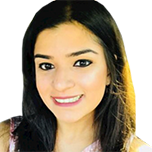NFTs: what are they and why are they so popular?
The NFT market has been on a rollercoaster ride in 2021 starting with the $69m sale of a digital artwork backed by a cryptographic token known as an “NFT” hit the headlines recently. But what are NFTs and why are they suddenly so popular? Saloni Sardana investigates.


2021 was undoubtedly the year of bitcoin and cryptocurrencies took the world and Wall Street by storm. But even more, it was the year where non-fungible-tokens (NFTs) , which were considered obscure as recently as many months ago, went truly mainstream.
So, what are NFTs and why did they become so popular this year?
March was when NFTs really started making headlines. It was all down to auction house Christie’s record-breaking NFT sale: a piece of digital art, called “Everydays: The First 5,000 Days”, created by Mike Winkelmann, a graphic designer better known in the online art world as “Beeple”, sold for $69.3m. It was a collage of 5,000 pieces of digital art that Beeple has been producing on a daily basis since 2007.
It was the first time that Christie’s had listed an entirely digital piece of work in its 250-year history, and was one of the first milestones that triggered the incredible rise of “non-fungible tokens”, or NFTs.
MoneyWeek
Subscribe to MoneyWeek today and get your first six magazine issues absolutely FREE

Sign up to Money Morning
Don't miss the latest investment and personal finances news, market analysis, plus money-saving tips with our free twice-daily newsletter
Don't miss the latest investment and personal finances news, market analysis, plus money-saving tips with our free twice-daily newsletter
Yes, but what are NFTs?
NFTs are cryptographic tokens – much like a cryptocurrency – that are recorded on a blockchain and can be used to prove the authenticity, ownership and provenance of anything – physical or non-physical – such as artwork, collectable cards, or real estate, for example, in much the same way as a blockchain can be used to settle financial transactions or track elements in a supply chain. “Non-fungible” implies the token is unique and cannot be duplicated or swapped for anything else (unlike individual bitcoins, for example, which are “fungible”).
It is worth stressing that when someone buys an artwork that is authenticated by an NFT, they are not actually buying the digital asset per se. Instead they are purchasing a digitally-authenticated note which states that there is only one owner. Anybody can download a copy of the file or link corresponding to whatever the NFT is tokenising, but only the NFT owner holds the contract stating their ownership rights.
Why were NFTs introduced?
They have been presented as a solution that ascertains ownership over an object that can otherwise easily be reproduced. Unlike a traditional painting or sculpture, digital artwork is trivially easy to duplicate – it’s just a matter of downloading a copy. NFTs prove authenticity in the same way that the blockchain ensures a single bitcoin is owned only by one person.
Unlike physical pieces of art which can be broken, lost or destroyed, NFTs cannot be destroyed as they are recorded on a blockchain (a blockchain is an immutable record of transactions – if you need to know more, take a look at my colleague Dominic’s explanation here) in the same way as cryptocurrency transactions are. Most NFTs use the ethereum blockchain, but there are others.
How NFTs took the world by storm
NFTs are not just for tokenising assets. They can also act as smart contracts – contracts that are programmed to automatically execute certain actions in certain conditions. So in the case of “Everydays”, for example, the NFT gives the originator of the token a cut of future sales, with Beeple receiving 10%. This can help artists to secure a reliable source of income – and more importantly perhaps, a chunk of future resale value.
Are NFTs new?
NFTs are not entirely new. The first type of NFTs to hit the market were “Coloured Coins” in 2012, which are bitcoin tokens with extra functionality that allowed them to represent other assets on the blockchain.
In 2017 (notably, another boom/bubble period for crypto generally), NFTs and digital art came together to create “Cryptokitties” – digitally-created cartoon cats that can be bought and sold with NFTs verifying ownership. Crypokitties were created "to explore the concept of digital scarcity, implement a non-fungible token within smart contracts”, says their creator.
But a renewed interest in cryptocurrencies and a boom in digital art have thrust NFTs into mainstream consciousness. It’s not just obscure digital artists getting in on the act – earlier this year visual artist and musical performer Grimes, better known today perhaps as Elon Musk’s ex-partner, made $6m in minutes, by selling digital art backed by NFTs.
Jack Dorsey, co-founder and – until recently – chief executive of Twitter, also got involved by auctioning off the first tweet ever to appear on the social media website. The tweet – from Dorsey’s account – simply said "just setting up my twitter”. It sold for $2.9m.
The winner of the auction received a “digital certificate” of Dorsey’s first ever tweet. What does that actually mean? The tweet remains publicly available on the platform under Dorsey’s account. And the “owner” – as certified by the NFT – won’t be able to delete it or do anything with it. They will merely have been recorded as being the owner.
It is perhaps this which has left many people scratching their head – vast amounts of money are exchanging hands with no apparent benefit apart from the knowledge that you are the owner of an original, one which may have spawned millions of entirely identical copies. Some proponents compare it to owning the Mona Lisa versus owning a student poster of said masterpiece, but unsurprisingly, that’s not an argument to convince the sceptics.
The most popular NFTs of 2021
There have been several blockbuster NFTs in the last year. Beeple was the biggest, but data analytics firm TRG Datacenters has had a look at some of the other most-searched-for NFT art pieces between January and September 2021, based on Google Trends data.
The most popular NFT by search was Dorsey’s first tweet, mentioned above. The second one was Hashmasks, a collection of more than 16,000 unique digital assets made together in collaboration with 70 artists worldwide. In February, the project “sold its collection of 16,384 NFTs for $16 million in less than a week, with the most expensive Hashmask selling for 420 ETH ($650,000),” according to industry website The Block Crypto.
The third most popular NFT by search volume was none other than the iconic Doge meme, featuring the now-famous Shiba Inu Japanese dog breed, which sold for $4m in June this year. “After being fractionalised into 17 billion pieces — split up to allow for community ownership — the NFT is now valued at $220 million,” Business Insider reported in September.
Does the future for NFTs hold boom or bust – or both?
There certainly seems to be no shortage of interest in NFTs. A number of crypto exchanges are keen to get involved. Brian Armstrong, CEO of America’s largest cryptocurrency exchange Coinbase, expects the NFT market to surpass the size of Coinbase’s cryptocurrency business, which recently reported third-quarter revenue of about $1.3bn.
In October, Coinbase signalled its intent to enter the NFT place by launching its own NFT marketplace. In early December, another such platform, Blockchain.com, announced it is launching its own NFT marketplace in coming weeks. Exchanges like Binance and FTX.US have already launched NFT marketplaces of their own.
But even with NFTs gaining popularity, as with any other asset class, there is always the risk that the bubble bursts. NFTs may be the white-hot phenomenon of the moment, but, as with any new technology, they still have some way to go before they are widely accepted and become truly mainstream.
Despite the eye-watering sums changing hands in headline-grabbing transactions, they are still very much a niche product, and may well turn out to be a passing fancy – digital tulips, perhaps (or Cryptokitties, even). Holders of tokens could end up sitting on a surplus of NFTs with little buying interest if there is a slump in their popularity, in the same way as numerous bubbles have burst over the last several years.
However, as with the wider use of the blockchain, it does seem clear that because of NFTs’ usefulness as records of ownership in business, they could well be here to stay in one form or another.
Dominic Frisby has put together a downloadable Beginner’s Guide to Bitcoin for MoneyWeek subscribers, which includes a bonus section on other cryptocurrencies. If you’re not already a subscriber, sign up now to get the report plus your first six issues free.
Get the latest financial news, insights and expert analysis from our award-winning MoneyWeek team, to help you understand what really matters when it comes to your finances.
Saloni is a web writer for MoneyWeek focusing on personal finance and global financial markets. Her work has appeared in FTAdviser (part of the Financial Times), Business Insider and City A.M, among other publications. She holds a masters in international journalism from City, University of London.
Follow her on Twitter at @sardana_saloni
-
 ‘Why I have ditched my Help to Buy ISA for cash savings and the stock market’
‘Why I have ditched my Help to Buy ISA for cash savings and the stock market’Without the 25% bonus, my Help to Buy ISA is effectively redundant, says MoneyWeek writer Sam Walker.
-
 Is your inheritance tax allowance cut if you sell to downsize or sell your home to pay for care?
Is your inheritance tax allowance cut if you sell to downsize or sell your home to pay for care?Downsizing relief is a little-known benefit that could save your loved ones tens of thousands of pounds in inheritance tax after you’ve died.
-
 What's behind the big shift in Japanese government bonds?
What's behind the big shift in Japanese government bonds?Rising long-term Japanese government bond yields point to growing nervousness about the future – and not just inflation
-
 Halifax: House price slump continues as prices slide for the sixth consecutive month
Halifax: House price slump continues as prices slide for the sixth consecutive monthUK house prices fell again in September as buyers returned, but the slowdown was not as fast as anticipated, latest Halifax data shows. Where are house prices falling the most?
-
 Rents hit a record high - but is the opportunity for buy-to-let investors still strong?
Rents hit a record high - but is the opportunity for buy-to-let investors still strong?UK rent prices have hit a record high with the average hitting over £1,200 a month says Rightmove. Are there still opportunities in buy-to-let?
-
 Pension savers turn to gold investments
Pension savers turn to gold investmentsInvestors are racing to buy gold to protect their pensions from a stock market correction and high inflation, experts say
-
 Where to find the best returns from student accommodation
Where to find the best returns from student accommodationStudent accommodation can be a lucrative investment if you know where to look.
-
 The world’s best bargain stocks
The world’s best bargain stocksSearching for bargain stocks with Alec Cutler of the Orbis Global Balanced Fund, who tells Andrew Van Sickle which sectors are being overlooked.
-
 Revealed: the cheapest cities to own a home in Britain
Revealed: the cheapest cities to own a home in BritainNew research reveals the cheapest cities to own a home, taking account of mortgage payments, utility bills and council tax
-
 UK recession: How to protect your portfolio
UK recession: How to protect your portfolioAs the UK recession is confirmed, we look at ways to protect your wealth.
